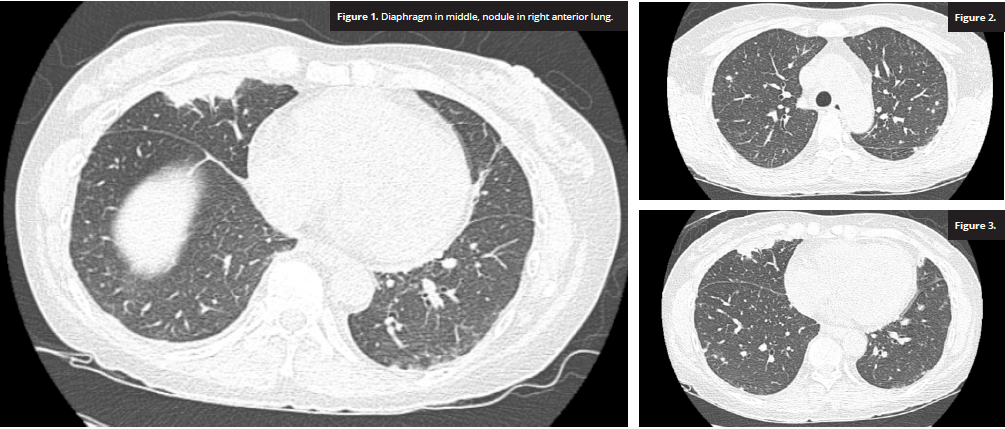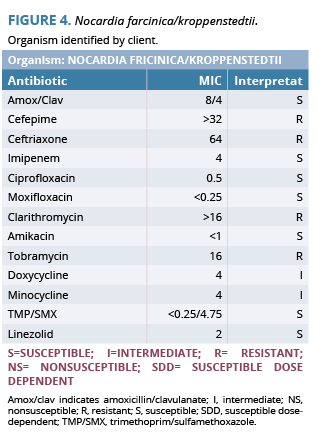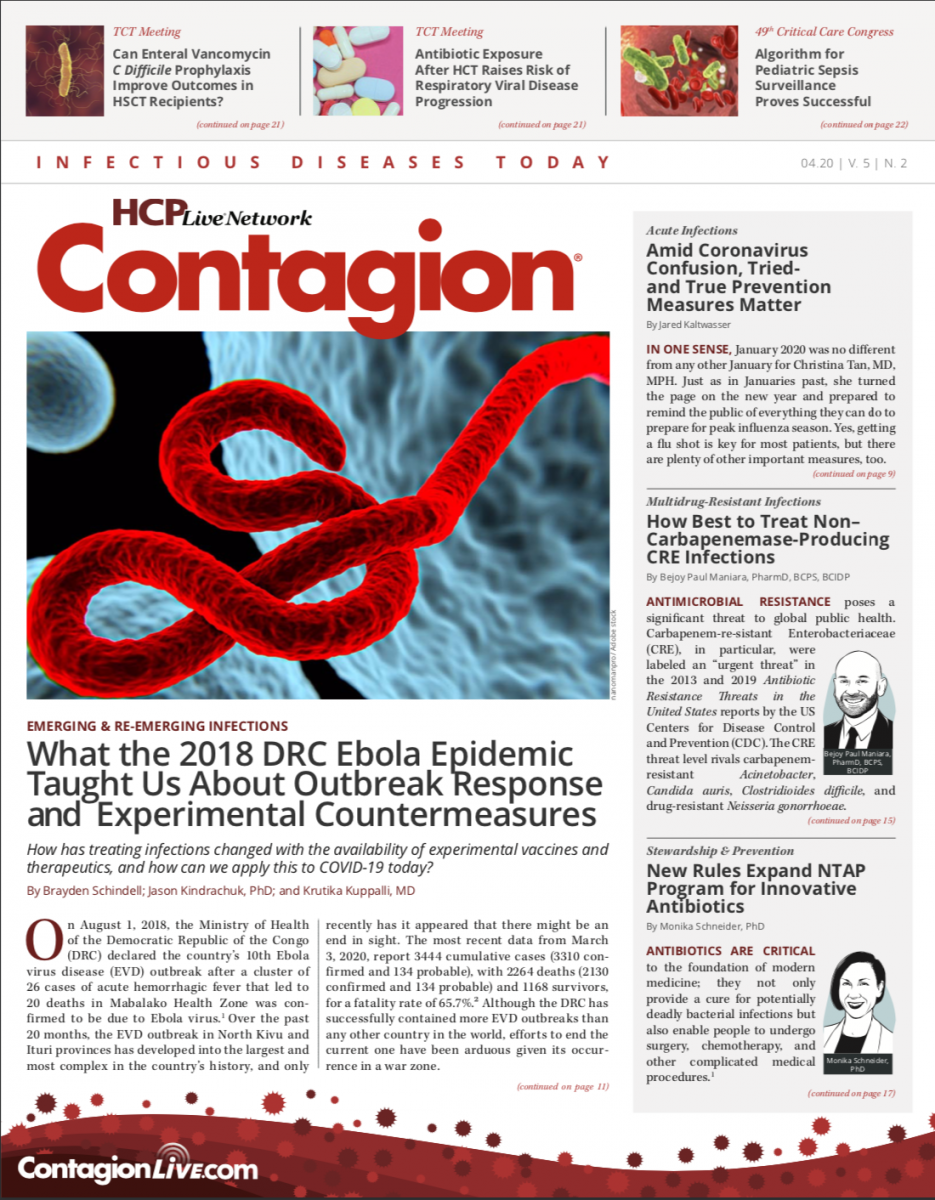A Case of Disseminated Nocardia farcinica Presenting as Fever of Unknown Origin in a Transplant Patient
Outcomes in disseminated nocardiosis are variable and depend on patient factors.
Final Diagnosis: Nocardia farcinica
HISTORY OF THE PRESENT ILLNESS
A 44-year-old woman with a medical history significant for end-stage renal disease underwent a deceased-donor kidney transplant. Nine months later, she presented to her nephrolo­gist in the fall with fevers and chills, 2 days after returning from a trip to China. She was prescribed a course of azithromycin and had a chest x-ray and urine culture performed. The chest x-ray was unremarkable, and the urine culture grew Proteus mirabilis. She was then prescribed a course of levofloxacin. She continued to have fevers at home, so she was instructed to present to the hospital for further testing. On admission, she reported having had right-side flank pain, pleuritic chest pain, nonproductive cough, and myalgias for about 1 week.
PAST MEDICAL HISTORY
The patient had a history of end-stage renal disease due to presumed immunoglobulin A nephropathy. She had been receiving hemodialysis for several months via tunneled catheter followed by peritoneal dialysis for 3 years prior to her transplant. At the time of transplant, she demonstrated prior exposure to Epstein-Barr virus and cytomegalovirus (CMV). Her donor also demonstrated prior exposure to CMV. Her postoperative course was complicated by leukopenia, which required adjustment of her immune suppression, temporary cessation of Pneumocystis prophylaxis with trimethoprim/sulfamethoxazole (TMP-SMX), and administration of colony-stimulating factors.
She also had low-level CMV DNAemia, without evidence of organ involvement, treated with valganciclovir about 5 months after transplant. This condition, a form of leukopenia, was attributed to a combination of CMV and medications and resolved about 3 months prior to presentation.
She also had a history of hypertension, hypothyroidism, hyper­parathyroidism, and gastroesophageal reflux disease.
KEY MEDICATIONS
At presentation, the patient was taking cyclosporine, myco­phenolate mofetil, and prednisone for immunosuppression. She was also taking prophylactic TMP-SMX and recently completed a course of valganciclovir. In addition, she took amlodipine, levothyroxine, famotidine, aspirin, atorvastatin, and ferrous sulfate.
EPIDEMIOLOGICAL HISTORY
The patient was born in China and grew up in Brazil. She spent 3 weeks in the region of Canton in southern China and returned 2 days prior to symptom onset. While in China, she visited family and traveled to rural areas but denied outdoor activities, contact with animals, and insect bites. She did undergo a dental extraction during her trip. Normally, she lived at home in the United States with her husband and 2 adult children, none of whom had any recent illnesses. She was not employed. She had no history of alcohol, tobacco, or illicit drug use.
PHYSICAL EXAMINATION
On initial presentation, the patient was febrile with a tempera­ture of 101.9° F. Her vital signs were otherwise within normal limits. She appeared well and in no distress. She was noted to have a grade 3/6 systolic murmur at the right upper sternal border that was not previously noted. Her exam was otherwise unremarkable.
STUDIES
Initial labs revealed a leukocytosis of 15.0 k/ mm3 with a high absolute neutrophil count of 14.1 k/mm3 and low absolute lymphocyte count of 0.2 k/mm3. A comprehensive metabolic panel was unremarkable. Her cyclosporine level was elevated at 725 ng/mL (goal: 100-150 ng/mL). A D-dimer was elevated to 3468 ng/mL. An inter­feron-gamma release assay was negative. The remainder of her initial labs, including lactic acid, routine blood cultures, urinalysis, respiratory viral panel, CMV viral load, and peripheral blood smear, were unrevealing.
A computed tomography (CT) scan of the chest was performed showed a new subpleural consolidative opacity in the anterior right middle lobe (Figure 1). A transthoracic echocar­diogram showed mild aortic regurgitation, not significantly changed from prior studies. Lower extremity Doppler ultrasound did not show deep venous thrombosis. She could not get intravenous contrast due to baseline chronic kidney function and refused a ventilation/perfusion scan.
CLINICAL COURSE
During the patient’s initial hospitalization, a definitive source of her fever was not found. She continued to have fevers despite treatment with vancomycin and cefepime. She declined a bron­choscopy and a biopsy of the right middle lobe consolidation and was started on isavuconazole for suspected fungal infection. She left against medical advice on hospital day 3 and was supplied with a short course of amoxicillin/clavulanate, which she completed. Due to intolerance she did not continue isavuconazole.
She was afebrile for about 2 weeks after her discharge, then developed nightly fevers again, as well as night sweats and unintentional 5-pound weight loss. Twenty-five days after her initial discharge, she was readmitted to the hospital. She was found to have an elevated CMV viral load of 2150 IU/mL (normal: <137) and was started on ganciclovir, although this was not thought to explain her entire presentation. A CT scan of the chest on admission showed innumerable new nodular densities throughout the lungs, with rapid development from prior scan (Figures 2 and 3).
Infectious disease specialists were consulted; the patient’s fungal and acid-fast bacilli blood and sputum cultures were sent, and serologic testing was performed for Bartonella, Brucella, and Coxiella. She also had routine blood cultures that were held for 14 days per request.
DIAGNOSTIC PROCEDURES AND RESULTS
Due to her new murmur and multiple pulmo­nary lesions, the patient underwent a transe­sophageal echocardiogram that showed “focal thickening/nonspecific focal hyperdensity on the right coronary cusp with central regurgita­tion.” Her routine blood cultures became positive for Nocardia on the fourth hospital day. She was empirically started on TMP-SMX and imipenem/ cilastatin, which was later switched to mero­penem. She had a magnetic resonance imaging (MRI) scan of her brain, which did not show central nervous system involvement of Nocardia.
She continued to have fevers until the tenth hospital day, and linezolid was added as a third empiric agent while further testing of her Nocardia isolate was in process. Repeat chest imaging showed bilateral pleural effusions, and she underwent a thoracentesis on hospital day 8. Her pleural fluid was transudative by Light’s criteria but grew Nocardia on culture. On imaging, she was also found to have a fluid collection around her transplanted kidney, which was drained by interventional radiology. The fluid cultures from this collection remained negative. Her blood cultures were persistently positive for 11 total days before clearing.
TREATMENT AND FOLLOW-UP
The Nocardia isolate was sent out for additional testing and returned as Nocardia farcinica. She was treated with TMP-SMX, meropenem, and linezolid while in the hospital. After her blood cultures cleared, she was transitioned to a 3-drug oral regimen consisting of amoxicillin/clavu­lanate, moxifloxacin, and TMP-SMX based on susceptibility testing (Figure 4).
Her CMV DNAemia was thought to be reac­tivation in the setting of acute illness. Her viral load became undetectable on ganciclovir, and she was transitioned to oral valganciclovir. She was discharged after 20 days in the hospital. She was noted to be feeling well at follow-up visits.
DISCUSSION
Nocardia species are aerobic gram-positive branching rods that display weak acid-fast staining.1 The taxonomy of the genus Nocardia has been rapidly evolving because of improved molec­ular testing. The number of identified species is debatable, with some sources citing more than 90 species, including more than 50 recognized as causing disease in humans.2
The most common human pathogens were members of what was once called the Nocardia asteroides complex, but many species that were formerly in this group have been reclassified. N nova, N farcinica, N cyriacigeorgica, N abscessus, and N brasiliensis are now among the most common species.3 In some case reviews, N farcinica has been observed to have higher rates of antibiotic resistance than other species.4,5 Studies in mice have also suggested that N farcinica may be more virulent and likely to cause disseminated infection than other species.6
Nocardia are not part of the normal human flora, but they are found in the environment worldwide and can be inhaled or directly inoculated into the skin.7 Immunosuppression, especially diminished cell-mediated immunity, is a well-documented risk factor for nocardiosis, with approximately two-thirds of cases occurring in patients with an underlying immunocompro­mised condition.7 However, immunocompetent hosts can develop nocardiosis, as well; they tend to develop localized skin infections. Immune-compromised hosts are more likely to develop pulmonary or disseminated disease.8
Pulmonary disease can have many presenta­tions, with symptoms including cough, dypsnea, hemoptysis, and weight loss. Radiographic find­ings are nonspecific and include nodules and cavitary lesions.9 Nocardia can disseminate to nearly any organ, particularly the central nervous system. Therefore, MRI screening of all patients with pulmonary or disseminated disease is recommended.⁸ Bacteremia, as seen in this patient, is relatively rare.10
In patients with solid organ transplant, multiple patient factors have been associated with a higher risk of nocardiosis, including high trough levels of calcineurin inhibitors, use of high-dose corticosteroids, history of CMV infection, patient age, and length of stay in the intensive care unit after trans­plant.11,12 Although many transplant patients take TMP-SMX as Pneumocystis prophylaxis and this drug is the mainstay of treatment for nocardiosis, it is not clear if taking prophylactic doses of TMP-SMX provide some protection against developing Nocardia-related infections.11 Patients who developed nocardiosis while on prophylactic TMP-SMX have not been found to have higher rates of TMP-SMX resistance, as is the case here.10
Nocardia is slow growing, and routine plates and cultures are frequently discarded before growth is detected. If Nocardia is suspected, cultures can be held for a prolonged period of 2 to 3 weeks. Various selective media can also help isolate Nocardia from contaminated speci­mens, such as sputum.11
Trimethoprim/sulfamethoxazole is generally used as first line-therapy for nocardiosis, but combination therapy is often used for severe or disseminated disease.13 Susceptibility varies greatly among species, so susceptibility testing is recommended for all cases to guide therapy.14 Antimicrobial therapy for at least 6 to 12 months is recommended. Lowering immune suppression as much as possible is also recommended.
Outcomes in disseminated nocardiosis are variable and depend on patient factors, including number of organs involved, as well as time to diagnosis and to initiation of appropriate therapy.9 Because nocardiosis can present in a variety of ways and be challenging to diagnose, a high level of clinical suspicion is required for this increasingly recognized pathogen as our popu­lation of immunosuppressed patients grows.


Spivack is a first-year infectious disease fellow at Temple University Hospital, in Philadelphia, Pennsylvania, where she also completed her medicine residency. She is interested in urban bioethics, social determinants of health, and all things infectious.Leone is a second-year internal medicine resident at Temple University Hospital. He is currently interested in hospital medicine and infectious disease.
References:
- Saubolle MA, Sussland D. Nocardiosis. J Clin Microbiol. 2003;41(10):4497-450 doi: 10.1128/JCM.410.4497-4501.2003.
- Conville PS, Brown-Elliot BA, Smith T, Zelazny AM. The complexities of Nocardia taxonomy and identification. J Clin Microbiol. 2017;56(1). pii: e01419-17. doi: 10.1128/JCM.01419-17.
- Brown-Elliot BA, Brown JM, Conville PS, Wallace RJ Jr. Clinical and laboratory features of the Nocardia spp. based on current molecular taxonomy. Clin Microbiol Rev. 2006;19(2):259-282. doi: 10.1128/CMR.19.2.259-282.2006.
- Hashemi-Shahraki A, Heidarieh P, Bostanabad SZ, et al. Genetic diversity and antimicrobial susceptibility of Nocardia species among patients with nocardiosis. Sci Rep. 2015;5:17862. doi: 10.1038/srep17862.
- Hitti W, Wolff M. Two cases of multidrug-resistant Nocardia farcinica infection in immunosuppressed patients and implications for empiric therapy. Eur J Clin Microbiol Infect Dis. 2005;24:142-144. doi: 10.1007/s10096-005-1285-y.
- Desmond EP, Flores M. Mouse pathogenicity studies of Nocardia asteroides complex species and clinical correlation with human isolates. FEMS Microbiol Lett. 1993;110(3):281-284. doi: 10.1111/j.1574-6968.1993.tb06335.x.
- Yang M, Xu M, Wei W, et al. Clinical findings of 40 patients with nocardiosis: a retrospective analysis in a tertiary hospital. Exp Ther Med. 2014;8(1): 25-30. doi: 10.3892/etm.2014.1715.
- Wilson JW. Nocardiosis: updates and clinical overview. Mayo Clin Proc. 2012;87(4):403-407. doi: 10.1016/j.mayocp.2011.11.016.
- Aggarwal D, Garg K, Chander J, Saini V, Janmeja AK. Pulmonary nocardiosis revisited: a case series. Lung India. 2015;32(2):165-168. doi: 10.4103/0970-2113.152638.
- Kontoyiannis DP, Ruoff K, Hooper DC. Nocardia bacteremia. report of 4 cases and review of the literature. Medicine (Baltimore). 1998;77(4):255-267. doi: 1097/00005792-199807000-00004.
- Coussement J, Lebeaux D, van Delden C, et al; European Study Group for Nocardia in Solid Organ Transplantation. Nocardia infection in solid organ transplant recipients: a multicenter European case-control study. Clin Infect Dis. 2016;63(3):338-345. doi: 10.1093/cid/ciw241.
- Peleg AY, Husain S, Qureshi ZA, et al. Risk factors, clinical characteristics, and outcome of Nocardia infection in organ transplant recipients: a matched case-control study. Clin Infect Dis. 2007;44(10):1307-1314. doi: 10.1086/514340.
- Restrepo A, Clark N; Infectious Diseases Community of Practice of the American Society of Transplantation. Nocardia infections in solid organ transplantation: guidelines from the Infectious Diseases Community of Practice of the American Society of Transplantation. Clin Transplant. 2019;33(9):e13509. doi: 10.1111/ctr.13509.

